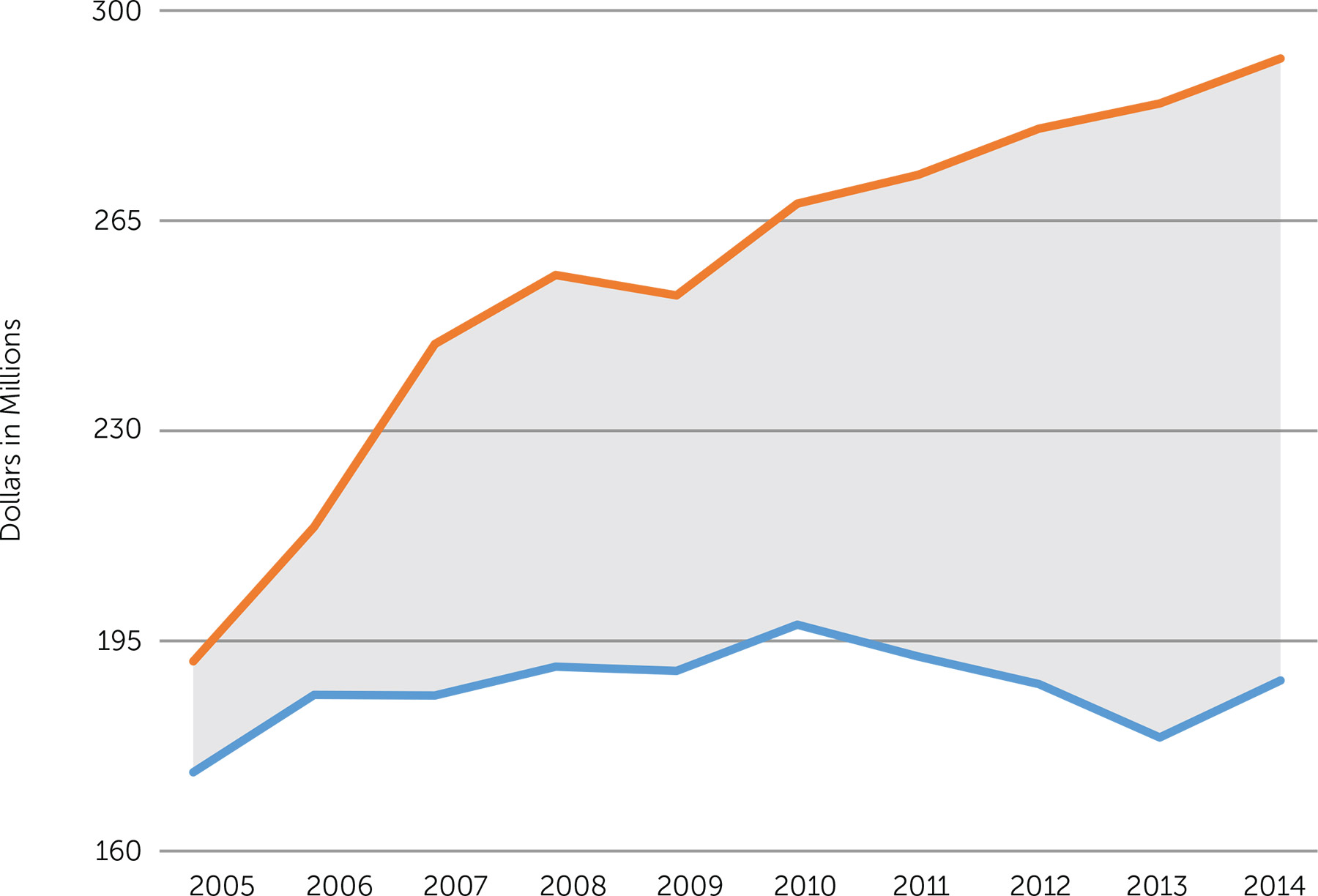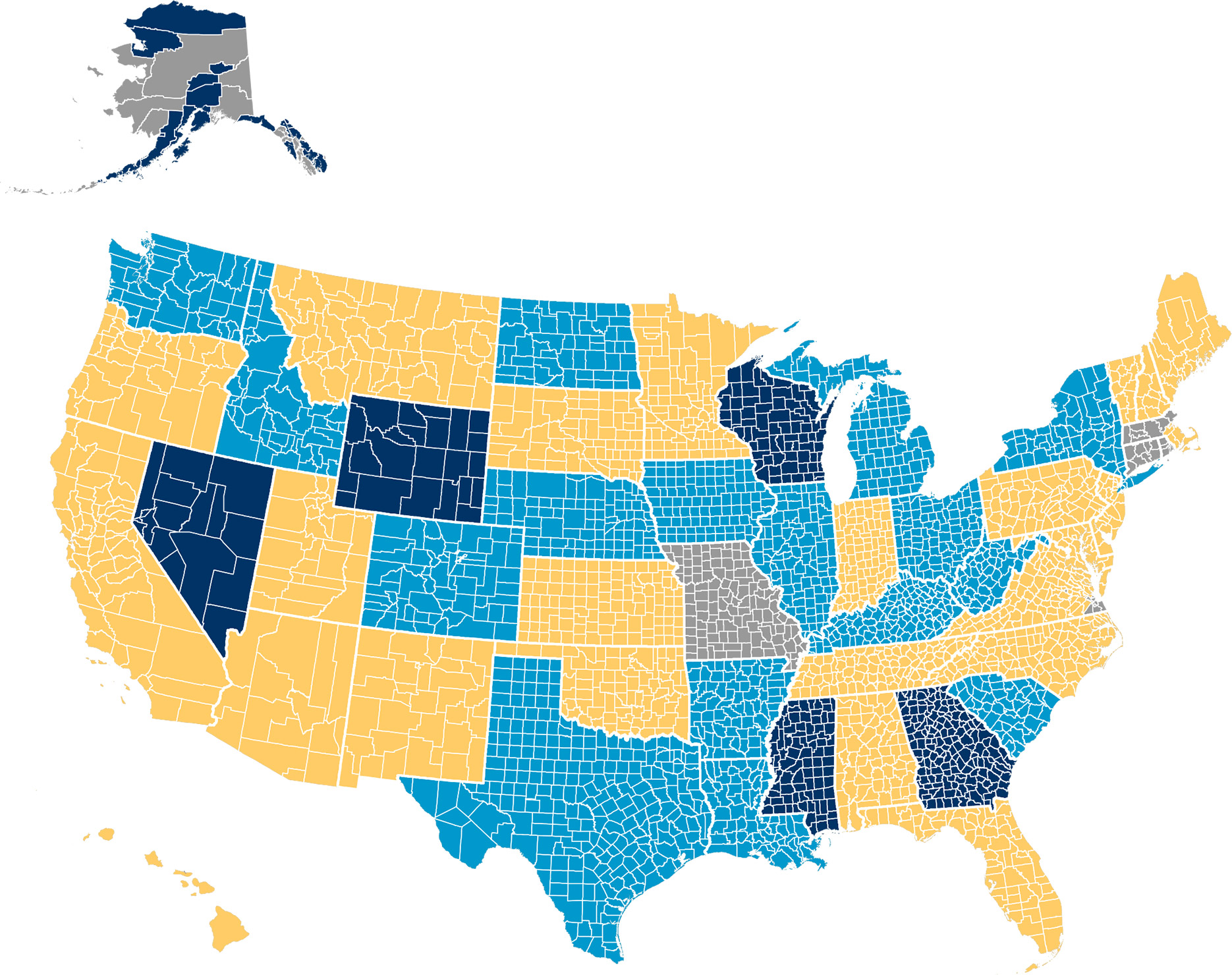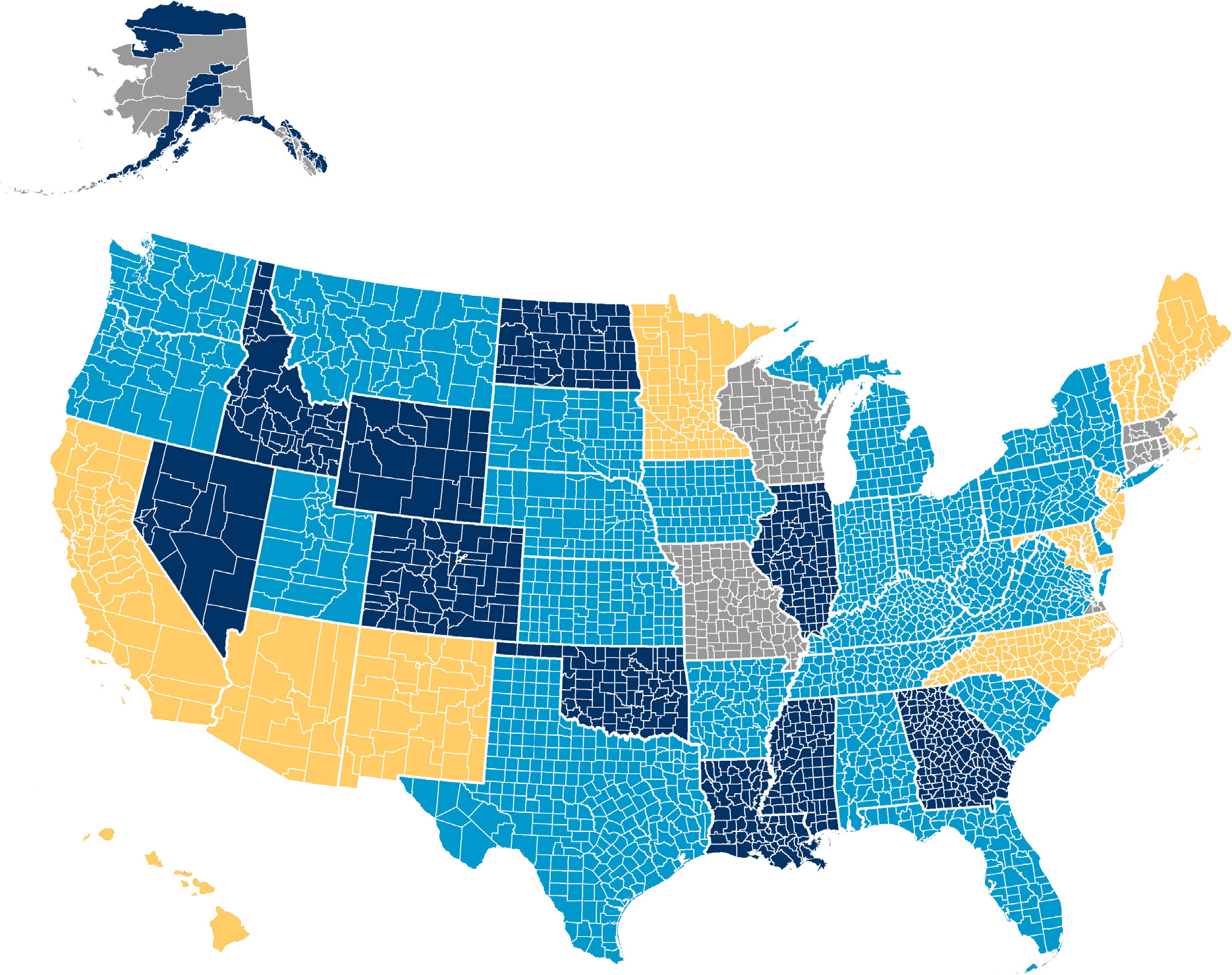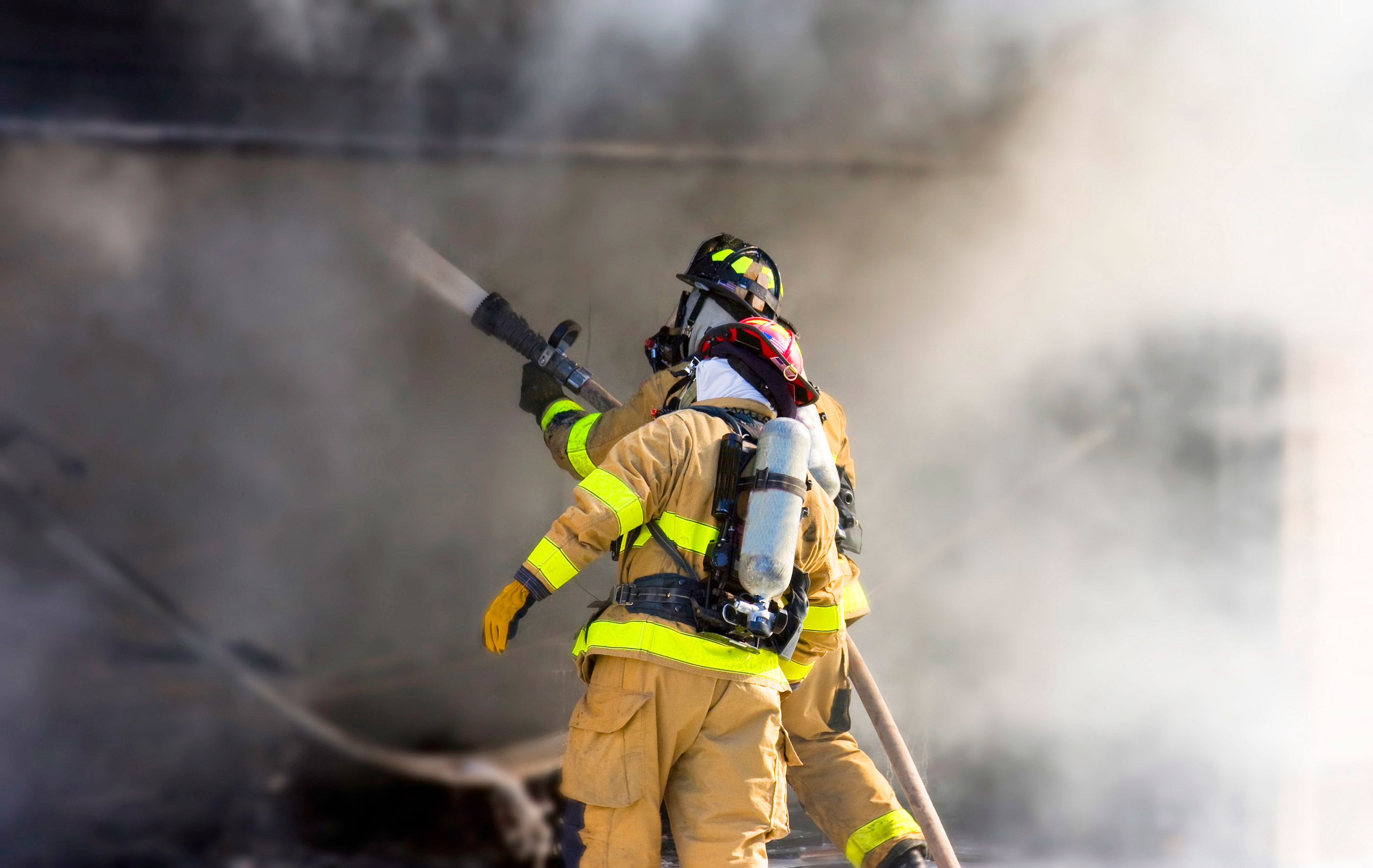Calling 911: Funding and Technological Challenges of County 911 Call Centers
Upcoming Events
Related News
Executive Summary
The efficacy of an emergency response system is a matter of life and death. The quickest way to receive assistance from public safety officials is by dialing 911. According to the U.S. Federal Communications Commission (FCC), federal, state and local governments manage, fund and operate 7,050 public-safety answering points (PSAPs) throughout the country.1 These answering points function as the vital links between 911 callers and public-safety personnel to dispatchers. However, changes in the telecommunications industry require PSAPs to implement costly upgrades in order to quickly locate and respond to callers. Concurrently, PSAP operators such as counties are receiving less in dedicated 911 funding, due to shifts in telecommunications preferences and states withholding fees that would otherwise be remitted to counties. Residents and counties are left in a position that may delay the delivery of life-saving assistance.
Understanding 911
In 1967, the President’s Commission on Law Enforcement and Administration of Justice recommended the creation of 911 for reporting emergency situations, and PSAPs were established throughout the country to receive emergency calls.2 PSAPs are the centers that connect to callers when they dial 911 and from which operators dispatch public safety officials. At its onset, 911 simply connected a caller with an operator; however, the operator did not immediately receive information about the caller, such as their number or their location. Since the implementation of 911, PSAP systems throughout the country have seen a series of upgrades.3 For example, with the advance of wireless phones, 911 systems were upgraded to accommodate wireless calls, share a caller’s location and the ability for 911 operators to identify the location of the closest cell tower to the caller (known as “Enhanced 911”). Currently, PSAPs throughout the country are in different stages of transitioning to Next Generation 911 (NG911).4 NG911 allows for the exchange of digital information, such as texts and pictures, between the public and PSAPs. Each of these enhancements required significant changes to existing systems since they did not have the capabilities to support new technologies.
911 Operation
$3.4 billion spent on 911 by 40 states and DC in 2015.
States, counties and cities may operate their own PSAPs, or they may consolidate these responsibilities. Counties in all 48 states with county governments and the District of Columbia operate, manage and fund their own PSAPs, often mandated by the state. 5 For example, Minn. and Wash. require all their counties to operate a PSAP.6 Counties in Va. and Md. are mandated to operate their PSAPs based on an Enhanced 911 system.7 West Virginia mandates that PSAPs must be operable within every county or municipality, though counties are largely responsible for operating all of the state’s 61 PSAPs.8 Though not mandated, counties in Mich. each have their own 911 system that is regulated by the state.9 Thirty-seven (37) state governments also operate their own PSAPs, most often for state police or for public universities, as do cities in 49 states.10
PSAPs incur a variety of costs, both operational expenses and capital expenditures. In 2015, 40 states and the District of Columbia reported, cumulatively, $3.4 billion for total 911 spending.11 Because emergencies happen at all hours, PSAPs must be staffed with operators 24/7. Having a minimum number of staff in any one call center, as well as ongoing training, may lead to high overtime costs. In addition, the responsibility of purchasing and maintaining expensive equipment falls onto the entity that operates the PSAP.
States set the rate of the 911 fees that consumers must pay.
To address costs and to improve efficiencies, some state, county and city governments consolidate the responsibility of a system’s operation and funding needs. States and local governments share PSAPs responsibilities in different ways. For example, some Kentucky counties operate their own PSAPs, while others consolidate operations with cities to improve efficiencies or defer this work to the state.12 In N.D., 21 PSAPs respond to calls from multiple jurisdictions, such as state, counties or cities.13 Minn. and Wash. also allow a multi-jurisdictional approach for operating PSAPs.14
911 Funding Structure
Funding for PSAPs comes from a variety of sources. Households and businesses who own wired telephones pay a fee specifically for 911 that is levied by either the state, county or city, or some combination thereof. In a majority of states, wireless, or cell, phone users also pay a fee. Users of pre-paid cell phones or voice over internet protocol (VoIP) devices may also be required to pay a one-time fee when they purchase a plan, although not all states or local governments have imposed a fee on these services. Local governments fund PSAP operations in other ways, besides 911 fees. For example, in Wis., some local governments have to pay for their PSAP out of their general fund.15 In states such as Ala., Idaho, N.Y., Texas and Va., grants may be available from the state to fund PSAPs.16
22 states and DC allow local governments to collect 911 fees.
States set the rate of the 911 fees that consumers must pay. These fees vary not only by state, but also by type of phone – that is wireline, wireless, prepaid or VoIP. For example, 10 states charge a lower 911 fee for wireless phones than for wireline phones.17 Further, states often charge lower 911 fees to users of prepaid phone plans than to users of wired phones. Additionally, users of prepaid phone plans pay a fee every time a plan is purchased as opposed to a monthly 911 fee. The fees paid on prepaid plans are most often paid per transaction, rather than on a monthly basis, and remitted to the state as a sales tax.18 A handful of states, including Colo., Ill., Ky., Nev. and Wis., allow counties to set their own fee. However, the county 911 fee is usually capped by the state.19

Most often, states collect the 911 fees. According to FCC, in 27 states only the state government has the authority to collect the 911 fees (See Map 1). For example, in Okla., telecommunication providers forward 911 fees collected to the state’s tax commission.20 In 16 states, there is a hybrid system where the state collects some fees and local governments collect the fees on other devices. In La., parishes collect fees from wireline and wireless plans while the state collects fees paid on prepaid plans.21 In six states – Alaska, Ga., Miss., Nev., Wis. and Wyo. — local governments or PSAPs collect fees directly. In these situations, providers remit fees directly to local governments.22
Map 1: 911 Fee Collection Authority
Notes: Missouri was the only state that did not respond to the 2016 FCC request for information on 911 fee collection and expenditure for calendar year 2015; therefore, the area is marked in grey. The dark grey areas in Conn., R.I., parts of Alaska, Mass. and Va. are counties or county-equivalents without county governments.
Source: NACo Analysis of FCC 2015 Data
States distribute all or portions of the collected 911 fee revenue to local governments in a handful of ways. For example, in Ariz., the state’s 911 office remits funds to local governments after reviewing budgets and proposals from these jurisdictions.23 In Kan., the state uses a funding formula to distribute the funds, while also guaranteeing that each PSAP receives at least $50,000 annually.24 In Tenn., the state’s Emergency Communications Board collects the 911 fees from providers and distributes funding to Emergency Communication Districts throughout the state.25 Some states, including Ore., Minn. and Ala., retain some of the 911 fee revenue for administrative purposes.26
Most often, states and local governments share the authority to decide the allocation of 911 fee revenues. In 23 states, both the states and local governments decide how to spend the 911 fee funding (See Map 2). In Fla., the state approves disbursements of fee revenues to cover for state costs, while counties have the authority to appropriate fees for their 911 operations.27 Contrarily, in 14 states, only the state government has the authority to approve how 911 fees must be spent. In Calif., only the state government has the authority to approve local government expenditures of 911 funds collected.28 In another 11 states, this authority is granted only to local entities. For example, Colo. statute permits local governments to expend 911 funds for any purposes as outlined in statute.29 Depending on the state, these expenses may be spent on leasing, purchasing or maintaining equipment; salaries and training of operators; administrative costs; and radio networks.30
Map 2: 911 Fee Revenue Allocation Authority
Notes: Missouri was the only state that did not respond to the 2016 FCC request for information on 911 fee collection and expenditure for calendar year 2015; therefore, the area is marked in grey. Wisconsin did not respond to this question in responding to the 2016 FCC survey. The dark grey areas in Conn., R.I., parts of Alaska, Mass. and Va. are counties or county-equivalents without county governments.
Source: NACo analysis of FCC 2015 data
34 states and DC let local governments decide how to spend some or all the 911 fee revenues.
Challenges Facing PSAPs and Counties
Rapid changing technology, consumer behavior and limited funding mechanisms are posing significant challenges to PSAPs, including those operated and funded by county governments.
Consumers are moving from wired phones to wireless and prepaid phone plans that carry a lower 911 fee. From 2003 to 2015, the percentage of adults in the United States that only had wireless telephone service grew from under 5 percent to over 47 percent.31 In 2015, 20 percent of emergency phone calls were made on wired telephones, while 80 percent were made on wireless devices.32 The number of 911 calls from wired telephones dropped by 13.4 percent, while 911 calls from wireless phones increased by 9.8 percent in just one year, between 2014 and 2015.33 Other factors also come into play. The prepaid cell phone market continues to grow; however, not all states charge comparable fees for these devices. Those that do collect these fees only receive revenue when a consumer purchases a plan, rather than on a month-to-month basis.
80 percent of 911 calls were made on wireless devices in 2015.
Kentucky exemplifies the dire situation facing some counties operating 911 systems. Eighty (80) percent of 911 calls in the state come from wireless phones despite such users only paying for 20-25 percent of the total 911 fees.34 Wireless users in Ky. pay $0.70 a month, which is collected directly by the state.35 Of this amount, 70 percent flows back to localities while the remainder stays with the state. Meanwhile, wired telephone 911 fees are collected directly by counties, which may charge up to $4.00 a month for wired phones. However, the share of the population that uses wired telephones has decreased. In addition, prepaid cell phone users in the state make up a large share of the communications market (approximately 22 percent) but pay no fees directly to counties.36 As the number of wireless phone users increases for both monthly and prepaid plans, less 911 funding comes into counties, due in part to the lower 911 fee on these devices. Because income from wired phones has decreased, counties in Ky. rely increasingly on their general fund revenues to operate PSAPs.
In other situations, existing language in state statute may be outdated with respect to prepaid or VoIP plans. N.M. has a 911 service fee on wired and wireless phones; however, such fees do not exist for prepaid phones. As the use of such phones increases, the state and thus local governments are unable to collect any revenue dedicated to 911 from these devices due to existing statutes.37
Further exacerbating counties’ 911 funding problems is that, in 2015, at least eight states diverted or transferred 911 fee revenues for purposes other than maintaining and upgrading PSAPs.38 According to the FCC, this amounted to $220.3 million.39 For example, in W.V., some of the 911 fee revenues collected by the state were deferred to other state operations as opposed to flowing to counties.40 In N.Y., from 2010 to 2015, the state retained close to $388.5 million in 911 fees owed to counties.41 In Ill., some of the 911 fee revenues are used by the state for non-public safety and/or unspecified uses.42
As counties receive less in dedicated 911 revenues, they turn to general fund money, as states increasingly limit their capacity to raise revenue.43 In addition, both states and the federal government are imposing more mandates on counties without providing funding. Counties must then prioritize federal and state mandate services over the services they normally provide and rely on their existing general fund revenue base to fund 911 operations, which leads to decreased funding for other services. For example, 55 percent of counties recorded general revenues covering a larger percentage of county expenses between 2007 and 2013, because of the decline in dedicated grants from states and the federal government.44
It is not uncommon for the revenue from 911 fees to fall short of the cost of running a PSAP. In N.D., most counties that support a PSAP pay for a third of operations out of their general fund, since the 911 fee they collect is insufficient.45 Counties in Iowa also must rely on their general fund to supplement the fees that they receive to properly fund their PSAPs.46 Counties in Ind. only receive 38 percent of the total necessary PSAP funding from 911 fees.47 Between 2005 and 2014, 911 fee revenues in Pa. grew by 9 percent, while the cost of operating PSAPs soared by 52 percent. As a result, 911 fee revenues covered only close to two-thirds of PSAP operating costs in 2014, a major drop from the 90 percent rate in 2005. 48
Figure 1: Pennsylvania 911 Fee Revenues and PSAPs Operating Costs, 2005-2014

Source: County Commissioners Association of Pennsylvania, 2015
These fiscal constraints make it very difficult for PSAPs to adapt to the latest technologies to better respond to emergencies. In response to these consumer behavior changes, the National Emergency Number Association (NENA) and the National 911 Program/U.S. Department of Transportation (DOT) initiated the Next Generation 911 (NG911) to be completed by 2020.
A PSAP that has adapted to NG911 would allow for text to 911 capabilities (including videos and pictures) and would enable first responders to quickly and properly locate emergency incidents. The upgraded PSAP would be able to identify where a caller is located and improve response times for first responders.49 This type of 911 would help in cases when a person cannot call 911. For example, in the 2016 Orlando nightclub shooting, victims texted their families asking them to contact 911 as they were unable to contact 911 directly.50
A lack of funding is the main hurdle to implementing NG911. According to FCC, 44 states allow for 911 fee revenues to be spent for NG911 implementation while the remaining six states do not.51 In 2015, 36 states spent almost $165 million on NG911 implementation.52 Switching all PSAPs to this new system is costly. Counties in states like N.Y., Mont., W.V., Ky. and Calif. cite funding as a primary barrier to the NG911 modernization.53 Because counties are receiving less in 911 dedicated revenues, they are increasingly reliant on their general funds for these upgrades. New York county officials estimate NG911 updates to cost $2.2 billion.54 Monroe County, Ohio, which has a population of 14,600 and only $3.4 million in tax revenue, signed a contract worth $230,300 to upgrade their PSAP to the new system. 55 In Manatee County, Fla., a county with a population of 363,400, upgrades have cost the county $935,990. 56
36 states spent almost $165 million on NG911 implementation in 2015.
Counties throughout the country are looking for collaborative solutions for NG911 implementation. For example, to address the high costs associated with upgrades, counties in N.D. recently worked with cities, 911 operators and phone companies to establish a joint powers agreement that would specifically fund NG911. Under the agreement, the North Dakota Association of Counties serves as an intermediary between telecommunication vendors and the state to collect 911 fees, and to upgrade the PSAPs throughout the state, which includes NG911. Equipment used to provide NG911 service is leased from outside vendors, which greatly reduces the costs to local governments.57
In 2015, at least eight states diverted or transferred 911 fee revenues for purposes other than maintaining and upgrading PSAPs.
Conclusion
PSAPs provide a vital link between public safety officials and callers facing emergency situations, but changing technology and consumer preferences are hampering upgrades. Counties are major players in emergency management, operating and funding PSAPs across the country. Counties that operate PSAPs are facing a decline of dedicated revenues for 911 and the high cost of upgrading their systems to Next Generation 911. A number of solutions have been pursued in response to these problems, include updating existing statutes that may be silent on the types of telephones that fees may be collected from, returning dedicated funding from states back to counties or consolidating upgrade efforts with other local governments. Counties continue to work in partnership with other local governments, states and federal government for a secure, long-term solution that will help bring PSAPs nationwide into the 21st century.
Acknowledgments
Within the National Association of Counties, the author would like to thank Matt Chase, Emilia Istrate, Jonathan Harris, David Jackson, and Jacob Terrell for their helpful comments and contributions. He is also grateful to a number of state associations of counties that provided essential information and comments: California State Association of Counties, Kentucky Association of Counties, Maryland Association of Counties, Michigan Association of Counties, Association of Minnesota Counties, New Mexico Association of Counties, New York State Association of Counties, North Dakota Association of Counties, Washington State Association of Counties, and County Commissioners’ Association of West Virginia. A special thanks goes to Loudoun County, Va., Fire and Rescue Department that provided an inside view in 911 operations. A big thanks goes to Ricardo Aguilar who created the maps and graphics and Marc Moshcatel for checking the accuracy of the report and providing other helpful feedback. The author also expresses his appreciation to his Public Affairs colleagues for the graphic design and the website of the report.
For More Information, Contact:
Research Manager
research@naco.org
About the Counties Futures Lab
The NACo Counties Future Lab brings together leading national experts to examine and forecast the trends, innovations and promises of county government with an eye toward positioning America's county leaders for success. Focusing primarily on pressing county governance and management issues — and grounded in analytics, data and knowledge sharing — the Lab builds on the NACo Research Department's existing products and delivers research studies, reports and other actionable intelligence to a variety of venues in collaboration with corporate, academic and philanthropic thought leaders to promote the county government of the future.
Key-Terms
Public Safety Answering Point (PSAP): call center that receives 911 calls from the public
Next Generation 911: ongoing system upgrades to PSAPs to allow for the transmittal of data (including texts and images) over phone lines
Enhanced 911: upgraded 911 service that allows PSAP to receive wireless phone calls and for operators to identify the location of a wireless caller
Voice over Internet Protocol (VoIP): allows for voice and multimedia communications to be transmitted via the internet
Endnotes
[1] Federal Communications Commission, “911 Master PSAP Registry” (2017), available at https://www.fcc.gov/general/911-master-psap-registry (January 9, 2017).
[2] National Emergency Number Association, “911 Origin and History”, available at https://www.nena.org/?page=911overviewfacts (January 9, 2017).
[3] Ibid.
[4] Ibid.
[5] Federal Communications Commission, “911 Master PSAP Registry” (2017).
[6] Minn. Stat.§ 403.025; Wash. Rev Code § 38.52.510
[7] Va. Code Ann. § 56-484.16; Md. Code, Com. Law § 1-304
[8] W. Va Code §24-6
[9] Michigan Association of Counties, interview response, January 2017.
[10] Federal Communications Commission, “911 Master PSAP Registry” (2017).
[11] Federal Communications Commission, “Eighth Annual Report to Congress on State Collection and Distribution of 911 and Enhanced 911 Fees and Charges” (2016), available at http://transition.fcc.gov/Daily_Releases/Daily_Business/2017/db0113/DA-17-61A2.pdf.
[12] Kentucky Association of Counties, interview response, December 2016.
[13] Federal Communications Commission, “911 Master PSAP Registry” (2017).
[14] Association of Minnesota Counties, interview response, February 2017.; Wash. Rev Code § 38.52.510
[15] Federal Communications Commission, “Wisconsin Annual Collection of Information Related to the Collection and use of 911and E911 Fees” (2016), available at https://transition.fcc.gov/pshs/911/Net%20911/8th-Report/Wisconsin2016.pdf.
[16] Federal Communications Commission, “Eighth Annual Report to Congress on State Collection and Distribution of 911 and Enhanced 911 Fees and Charges” (2016).
[17] Ibid.
[18] Ibid.
[19] Ibid.
[20] Federal Communications Commission, “Oklahoma Annual Collection of Information Related to the Collection and use of 911and E911 Fees” (2016), available at https://transition.fcc.gov/pshs/911/Net%20911/8th-Report/Oklahoma2016.pdf.
[21] Federal Communications Commission, “Louisiana Annual Collection of Information Related to the Collection and use of 911and E911 Fees” (2016), available at https://transition.fcc.gov/pshs/911/Net%20911/8th-Report/Louisiana2016.pdf.
[22] Federal Communications Commission, “Eighth Annual Report to Congress on State Collection and Distribution of 911 and Enhanced 911 Fees and Charges” (2016).
[23] Federal Communications Commission, “Arizona Annual Collection of Information Related to the Collection and use of 911and E911 Fees” (2016), available at https://transition.fcc.gov/pshs/911/Net%20911/8th-Report/Arizona2016.pdf.
[24] Federal Communications Commission, “Kansas Annual Collection of Information Related to the Collection and use of 911and E911 Fees” (2016), available at https://transition.fcc.gov/pshs/911/Net%20911/8th-Report/Kansas2016.pdf.
[25] Federal Communications Commission, “Tennessee Annual Collection of Information Related to the Collection and use of 911and E911 Fees” (2016), available at https://transition.fcc.gov/pshs/911/Net%20911/8th-Report/Tennessee2016.pdf.
[26] Federal Communications Commission, “Eighth Annual Report to Congress on State Collection and Distribution of 911 and Enhanced 911 Fees and Charges” (2016).
[27] Federal Communications Commission, “Florida Annual Collection of Information Related to the Collection and use of 911and E911 Fees” (2016), available at [28] Federal Communications Commission, “California Annual Collection of Information Related to the Collection and use of 911and E911 Fees” (2016), available at https://transition.fcc.gov/pshs/911/Net%20911/8th-Report/California2016.pdf.
[29] Federal Communications Commission, “Colorado Annual Collection of Information Related to the Collection and use of 911and E911 Fees” (2016), available at https://transition.fcc.gov/pshs/911/Net%20911/8th-Report/Colorado2016.pdf.
[30] Federal Communications Commission, “Eighth Annual Report to Congress on State Collection and Distribution of 911 and Enhanced 911 Fees and Charges” (2016).
[31] National Health Interview Statistics, Wireless Substitutions: Early Release of Estimates from the National Health Interview Survey, July-December 2015 (2016), available at https://www.cdc.gov/nchs/data/nhis/earlyrelease/wireless201605.pdf (February 2, 2017).
[32] Federal Communications Commission, “Eighth Annual Report to Congress on State Collection and Distribution of 911 and Enhanced 911 Fees and Charges” (2016).
[33] Ibid.
[34] Kentucky Association of Counties, interview response, December 2016.
[35] Federal Communications Commission, “Kentucky Annual Collection of Information Related to the Collection and use of 911and E911 Fees” (2016), available at https://transition.fcc.gov/pshs/911/Net%20911/8th-Report/Kentucky2016.pdf.
[36] Kentucky Association of Counties, interview response, December 2016.
[37] New Mexico Association of Counties, interview response, January 2017.
[38] Federal Communications Commission, “Eighth Annual Report to Congress on State Collection and Distribution of 911 and Enhanced 911 Fees and Charges” (2016).
[39] Ibid.
[40] Ibid.
[41] Jon Dougherty, “County Leaders Fight for More Funding to Upgrade 911 System”, Time Warner Cable News, October 17, 2016, available at http://www.twcnews.com/nys/capital-region/news/2016/10/17/county-leaders-fight-for-more-funding-to-upgrade-911-system-.html (January 9, 2017).
[42] Susan DeMar Lafferty, “Will County to Demand Release of 911 Funds”, Chicago Tribune, September 13, 2016, available at http://www.chicagotribune.com/suburbs/daily-southtown/news/ct-sta-will-demands-911-funds-st-0914-20160913-story.html (January 9, 2017).
[43] Joel Griffith, Jonathan Harris and Emilia Istrate “Doing More with Less: State Revenue Limitations and Mandates on County Finances”, National Association of Counties, NACo Policy Research Paper Series, Issue 5, November 2016.
[44] Ibid.
[45] North Dakota Association of Counties, Interview Response, December 2016.
[46] Federal Communications Commission, “Eighth Annual Report to Congress on State Collection and Distribution of 911 and Enhanced 911 Fees and Charges” (2016).
[47] Ibid.
[48] Data from “911 System Costs and Funding Sources” from the County Commissioners Association of Pennsylvania, 2015. After significant efforts, the Pa. legislature passed Penn. Act 12 of 2015 that increased the 911 fee in 2015 to help address the funding problem.
[49] United States Department of Transportation, “Next Generation 911”, available at http://its.dot.gov/factsheets/pdf/JPO_NextGen911_v2.pdf.
[50] Derek Staahl, “Orlando Shooting Underscores Need for Text-to-911 System in Arizona, Attorney Says”, AZ Family, June 14, 2016, available at http://www.azfamily.com/story/32213908/orlando-shooting-underscores-need-for-text-to-911-system-in-arizona-attorney-says (January 9, 2017).
[51] Federal Communications Commission, “Eighth Annual Report to Congress on State Collection and Distribution of 911 and Enhanced 911 Fees and Charges” (2016).
[52] Ibid.
[53] NACo analysis of responses of interviews with the state associations of counties in N.Y., Mont., W.Va., Ky., and Calif. between November, 2016- December, 2016.
[54] New York State Association of Counties, “Funding 911 Services in New York State” (2015), available at http://www.nysac.org/files/NYSAC%20Funding%20911%20Report-2016(1).pdf.
[55] NACo Analysis of U.S. Census Bureau – Census of Individual Governments: Finance, 2012; Editorial, “Monroe County gets 911 Upgrade”, January 13, 2017, available at http://www.mariettatimes.com/opinion/editorials/2017/01/monroe-county-gets-911-upgrade/ (January 9, 2017).
[56] NACo Analysis of U.S. Census Bureau – Population Estimates Program, 2015; Claire Aronson, “New 911 Technology Will Allow Text Messages to Be Sent to Manatee County Emergency Communications Center in Future”, April 11, 2016, available at http://www.bradenton.com/news/local/article71219752.html (January 9, 2017)
[57] North Dakota Association of Counties, Interview Response, December 2016.


